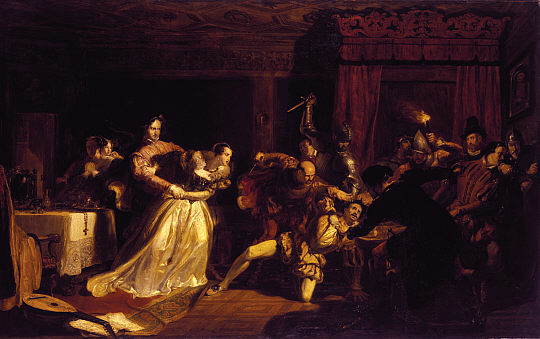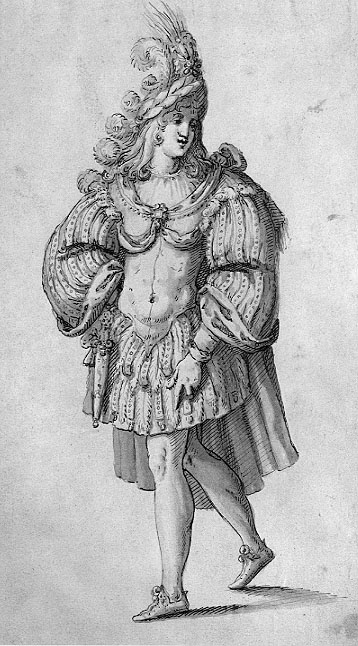|
Murder Of Lord Darnley
The murder of Henry Stuart, Lord Darnley, second husband of Mary, Queen of Scots, took place on 10 February 1567 in Edinburgh, Scotland. Darnley's lodgings were destroyed by gunpowder; his body and that of his servant were found nearby, apparently having been strangled rather than killed in the explosion. Suspicion was placed upon Queen Mary and the James Hepburn, 4th Earl of Bothwell, Earl of Bothwell, whom Mary went on to marry three months after Darnley's murder. Bothwell was indicted for treason and acquitted, but six of his servants and acquaintances were subsequently arrested, tried, and executed for the crime. Location Darnley was murdered at the "Old Provost's House" of the Kirk o' Field (formally, St Mary in the Fields). The kirk was named for its original situation outside the Edinburgh town walls#Background, early town walls, in fields to the south of Edinburgh. The Old Provost's House was built against the Flodden wall. James Hamilton, Duke of Châtellerault, buil ... [...More Info...] [...Related Items...] OR: [Wikipedia] [Google] [Baidu] |
Kirk O' Field Contemporary Sketch
Kirk is a Scottish and former Northern English word meaning 'church'. The term ''the Kirk'' is often used informally to refer specifically to the Church of Scotland, the Scottish national church that developed from the Scottish Reformation, 16th-century Reformation. Many place names and personal names are derived from wiktionary:kirk, kirk. Basic meaning and etymology As a common noun, ''kirk'' (meaning 'church') is found in Scots language, Scots, Scottish English, Ulster-Scots dialects, Ulster-Scots and some English language in England, English dialects, attested as a noun from the 14th century onwards, but as an element in placenames much earlier. Both words, ''kirk'' and ''church'', derive from the Koine Greek κυριακόν (δωμα) (kyriakon (dōma)) meaning ''Lord's (house)'', which was borrowed into the Germanic languages in late antiquity, possibly in the course of the Gothic Christianity, Gothic missions. (Only a connection with the idiosyncrasies of Gothic language ... [...More Info...] [...Related Items...] OR: [Wikipedia] [Google] [Baidu] |
Cowgate
The Cowgate (Scots language, Scots: The Cougait) is a street in Edinburgh, Scotland, located about southeast of Edinburgh Castle, within the city's World Heritage Site. The street is part of the lower level of Edinburgh's Old Town, Edinburgh, Old Town, which lies below the elevated streets of South Bridge, Edinburgh, South Bridge and George IV Bridge. It meets the Grassmarket at its west end and Holyrood, Edinburgh, Holyrood Road to the east. History Early history The Cowgate developed around 1330 and represented Edinburgh’s first municipal extension. The original settlement on the Cowgate was concentrated on the south side because of a Burn (landform), burn on the north, though that was filled in around 1490 and built upon. Archaeological excavations in the 2006 and 2007 found a boundary ditch, dating to the 14th century, near St Patrick's Church, Edinburgh, St Patrick's Church which might have been the full extent of the Cowgate at that time. The street's name is rec ... [...More Info...] [...Related Items...] OR: [Wikipedia] [Google] [Baidu] |
Solder
Solder (; North American English, NA: ) is a fusible alloy, fusible metal alloy used to create a permanent bond between metal workpieces. Solder is melted in order to wet the parts of the joint, where it adheres to and connects the pieces after cooling. Metals or alloys suitable for use as solder should have a lower melting point than the pieces to be joined. The solder should also be resistant to oxidative and corrosive effects that would degrade the joint over time. Solder used in making electrical connections also needs to have favorable electrical characteristics. Soft solder typically has a melting point range of , and is commonly used in electronics, plumbing, and sheet metal work. Alloys that melt between are the most commonly used. Soldering performed using alloys with a melting point above is called "hard soldering", "silver soldering", or brazing. In specific proportions, some alloys are eutectic — that is, the alloy's melting point is the lowest possible for a ... [...More Info...] [...Related Items...] OR: [Wikipedia] [Google] [Baidu] |
Holyroodhouse
The Palace of Holyroodhouse ( or ), commonly known as Holyrood Palace, is the official residence of the British monarch in Scotland. Located at the bottom of the Royal Mile in Edinburgh, at the opposite end to Edinburgh Castle, Holyrood has served as the principal royal residence in Scotland since the 16th century, and is a setting for state occasions and official entertaining. The palace adjoins Holyrood Abbey, and the gardens are set within Holyrood Park. The King's Gallery was converted from existing buildings at the western entrance to the palace and was opened in 2002 to exhibit works of art from the Royal Collection. King Charles III spends one week in residence at Holyrood at the beginning of summer, where he carries out a range of official engagements and ceremonies. The 16th-century historic apartments of Mary, Queen of Scots, and the State Apartments, used for official and state entertaining, are open to the public throughout the year, except when members of the ro ... [...More Info...] [...Related Items...] OR: [Wikipedia] [Google] [Baidu] |
James Melville Of Halhill
Sir James Melville (1535–1617) was a Scottish diplomat and memoir writer, and father of the poet Elizabeth Melville. Life Melville was the third son of Sir John Melville, laird of Raith, in the county of Fife, who was executed for treason in 1548. One of his brothers was Robert, 1st Baron Melville of Monimail (1527–1621). James Melville in 1549 went to France to become page to Mary, Queen of Scots. Serving on the French side at the Battle of St. Quentin in 1557 Melville was wounded and taken prisoner. He subsequently carried out a number of diplomatic missions for Henry II of France. On Mary's return to Scotland in 1561 she gave Melville a pension and an appointment in her household. Sent to England as a diplomat, Melville included an account of his meeting with Elizabeth I in 1564 in his memoir. This often-quoted passage includes their discussion of the comparative attributes and accomplishments of the two queens. Elizabeth showed him miniature portraits and arranged ... [...More Info...] [...Related Items...] OR: [Wikipedia] [Google] [Baidu] |
Francisco De Busso
Francisco de Busso (died 1576) was an Italian courtier in the service of Mary, Queen of Scots. Busso was a Master of Household, in charge of provisions and household servants. Career Busso had been a servant and Master of Household to Mary of Guise (died 1560). He was a Knight of the Order of St James of the Sword. In 1552, Mary of Guise sent him as an envoy or diplomat to Mary of Hungary, Governor of the Netherlands, when she wanted her to return some letters of Henri Cleutin which had chanced into her possession. Mary, Queen of Scots, made him superintendent and overseer of her palaces and building works in September 1563. He was the Keeper of Holyrood Palace. His name appears in financial records of the court as "Senyeour Frances" or "Francisco". His first name is recorded as "John" in some official documents. He worked with William MacDowall to improve the gardens at Holyrood. A French diplomat, Paul de Foix, noted he was close to Mary. In July 1565, Mary gave him a damask si ... [...More Info...] [...Related Items...] OR: [Wikipedia] [Google] [Baidu] |
Privy Council Of Scotland
The Privy Council of Scotland ( — 1 May 1708) was a body that advised the Scottish monarch. During its existence, the Privy Council of Scotland was essentially considered as the government of the Kingdom of Scotland, and was seen as the most important element of central government. In the range of its functions the council was often more important than the Estates in the running the country. Its registers include a wide range of material on the political, administrative, economic and social affairs of the Kingdom of Scotland. The council supervised the administration of the law, regulated trade and shipping, took emergency measures against the plague, granted licences to travel, administered oaths of allegiance, banished beggars and gypsies, dealt with witches, recusants, Covenanters and Jacobites and tackled the problem of lawlessness in the Highlands and the Borders. The council was officially abolished in 1708 and merged with the Privy Council of England to cre ... [...More Info...] [...Related Items...] OR: [Wikipedia] [Google] [Baidu] |
Gunpowder
Gunpowder, also commonly known as black powder to distinguish it from modern smokeless powder, is the earliest known chemical explosive. It consists of a mixture of sulfur, charcoal (which is mostly carbon), and potassium nitrate, potassium nitrate (saltpeter). The sulfur and charcoal act as fuels while the saltpeter is an oxidizer. Gunpowder has been widely used as a propellant in firearms, artillery, rocketry, and pyrotechnics, including use as a blasting agent for explosives in quarrying, mining, building Pipeline transport, pipelines, tunnels, and road#Construction, roads. Gunpowder is classified as a Explosive#Low, low explosive because of its relatively slow decomposition rate, low ignition temperature and consequently low brisance, brisance (breaking/shattering). Low explosives deflagration, deflagrate (i.e., burn at subsonic speeds), whereas high explosives detonation, detonate, producing a supersonic shockwave. Ignition of gunpowder packed behind a projectile generates ... [...More Info...] [...Related Items...] OR: [Wikipedia] [Google] [Baidu] |
Royal Court Of Scotland
The Royal Court of Scotland was the administrative, political and artistic centre of the Kingdom of Scotland. It emerged in the tenth century and continued until it ceased to function when James VI inherited the throne of England in 1603. For most of the medieval era, the king had no "capital" as such. The Pictish centre of Forteviot was the chief royal seat of the early Gaelic Kingdom of Alba that became the Kingdom of Scotland. In the twelfth and thirteenth centuries Scone was a centre for royal business. Edinburgh only began to emerge as the capital in the reign of James III but his successors undertook occasional royal progress to a part of the kingdom. Little is known about the structure of the Scottish royal court in the period before the reign of David I when it began to take on a distinctly feudal character, with the major offices of the Steward, Chamberlain, Constable, Marischal and Lord Chancellor. By the early modern era the court consisted of leading nobles, offic ... [...More Info...] [...Related Items...] OR: [Wikipedia] [Google] [Baidu] |
Gordon Donaldson
Gordon Donaldson (13 April 1913 – 16 March 1993) was a Scottish historian. Life He was born in a tenement at 140 McDonald RoadEdinburgh and Leith Post Office Directory, 1912 off Leith Walk in northern Edinburgh on 13 April 1913 the son of Rachel Swan and Magnus Donaldson. He was of Shetland descent. Donaldson attended Broughton Elementary School (adjacent to his home) and then the Royal High School of Edinburgh (1921–31), before being awarded a scholarship to study at the University of Edinburgh. He also supplemented his income by undertaking some tutoring. After graduating in 1935 with a first-class Honours Degree in History ( MA), he gained his PhD in 1938 at the Institute of Historical Research in London, where he also won the David Berry Prize from the Royal Historical Society. Donaldson also has a DLitt degree. After working as an archivist at the General Register Office for Scotland 1938–1947, he was appointed to a lectureship in Scottish History at the ... [...More Info...] [...Related Items...] OR: [Wikipedia] [Google] [Baidu] |
Bastian Pagez
Bastian Pagez was a French servant and musician at the court of Mary, Queen of Scots. He was born in Auvergne. He devised part of the entertainment at the baptism of Prince James at Stirling Castle in 1566. When Mary was exiled in England, Bastian and his family continued in her service. The 19th-century historians Agnes Strickland and William Barclay Turnbull considered his court role as equivalent to the English Master of the Revels; in England he was Mary's chamber valet and designed her embroidery patterns. Christening at Stirling Bastian is first recorded at the Scottish court in 1565 when Mary and Henry Stewart, Lord Darnley bought him an elaborate and expensive suit of clothes costing over £100 Scots as a mark of their favour. James Melville of Halhill wrote in his ''Memoirs'' that Bastian was responsible for an entertainment in the Great Hall of Stirling Castle which offended the English guests at the baptism of the future James VI. Mary and thirty guests sat at a ro ... [...More Info...] [...Related Items...] OR: [Wikipedia] [Google] [Baidu] |
Masque
The masque was a form of festive courtly entertainment that flourished in 16th- and early 17th-century Europe, though it was developed earlier in Italy, in forms including the intermedio (a public version of the masque was the pageant). A masque involved music, dancing, singing and acting, within an elaborate stage design, in which the architectural framing and costumes might be designed by a renowned architect, to present a deferential allegory flattering to the patron. Professional actors and musicians were hired for the speaking and singing parts. Masquers who did not speak or sing were often courtiers: the English queen Anne of Denmark frequently danced with her ladies in masques between 1603 and 1611, and Henry VIII and Charles I of England performed in the masques at their courts. In the tradition of masque, Louis XIV of France danced in ballets at Versailles with music by Jean-Baptiste Lully. Development The masque tradition developed from the elaborate pageants and co ... [...More Info...] [...Related Items...] OR: [Wikipedia] [Google] [Baidu] |






